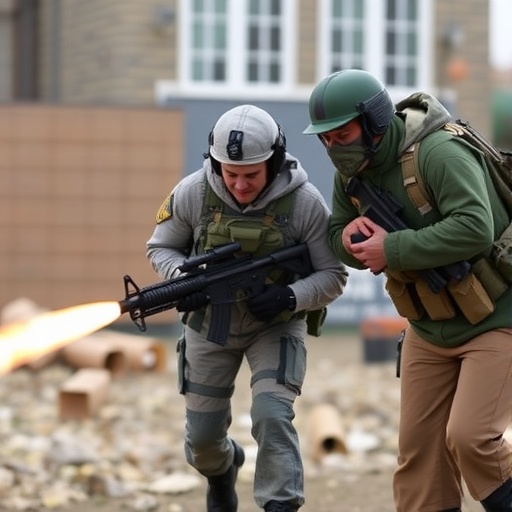ICE Weapons Spending Explodes 700% Under Trump: $70 Million Haul Includes Explosives and Missiles as Raids Ramp Up
In a dramatic escalation of border security measures, U.S. Immigration and Customs Enforcement (ICE) has poured over $70 million into weapons procurement since President Donald Trump’s return to the White House, marking a staggering 700% surge in spending compared to previous years. This massive outlay, revealed through federal procurement records, includes high-caliber explosives, chemical agents, and even guided missile warheads—items more akin to military arsenals than standard law enforcement gear. As immigration enforcement intensifies with nationwide raids targeting undocumented immigrants, critics warn of a dangerous militarization of domestic policing under the Trump administration.
- Inside the $70 Million Weapons Bonanza: From Tear Gas to Tactical Missiles
- Raid Operations Multiply: How Weapons Spending Ties to Trump’s Deportation Drive
- Voices of Concern: Experts and Lawmakers Decry ICE’s Militarized Turn
- Defending the Arsenal: Trump Officials Tout Necessity Amid Rising Threats
- Future Flashpoints: Implications for Borders, Budgets, and Civil Rights
The surge in ICE‘s weapons spending underscores a broader push by the Trump administration to fortify immigration enforcement through advanced military equipment. Documents obtained by investigative journalists show that contracts awarded in the first six months of Trump’s second term alone exceed $70 million, dwarfing budgets from the Biden era. This isn’t just about numbers; it’s a shift toward equipping agents with tools designed for high-threat combat scenarios, raising questions about the future of civil liberties at the border.
Inside the $70 Million Weapons Bonanza: From Tear Gas to Tactical Missiles
At the heart of this procurement frenzy is a diverse array of military-grade hardware that’s transforming ICE into what some experts call a ‘paramilitary force.’ Federal spending data from the Department of Homeland Security (DHS) highlights key purchases: over $15 million allocated for non-lethal chemical weapons, including advanced tear gas canisters and pepper spray munitions capable of dispersing crowds over wide areas. Another $20 million went toward explosive devices, such as flash-bang grenades and breaching charges used to storm buildings during raids.
Perhaps most alarming are the $25 million in guided missile warheads and drone-compatible munitions, sourced from defense contractors like Raytheon and Lockheed Martin. These aren’t off-the-shelf items; they’re precision-engineered for aerial deployment, suggesting ICE is preparing for scenarios involving unmanned surveillance and rapid response along the U.S.-Mexico border. ‘This level of military equipment for an agency focused on immigration is unprecedented,’ said Sarah Mehta, a policy analyst at the American Civil Liberties Union (ACLU). ‘We’re seeing tools borrowed from war zones repurposed for community policing.’
To break it down further, here’s a snapshot of the major categories in ICE’s recent weapons spending:
- Chemical Agents and Riot Control: $15.2 million for 50,000 units of OC (oleoresin capsicum) spray and CS gas projectiles, enhancing crowd control during mass deportation operations.
- Explosives and Breaching Tools: $20.4 million for 10,000 flash-bang grenades and explosive entry kits, aimed at facilitating quicker access in high-risk arrests.
- Guided Munitions and Missiles: $25.1 million for warheads compatible with border patrol drones, including infrared-guided variants for nighttime operations.
- Ammunition and Firearms Upgrades: $9.3 million for armor-piercing rounds and enhanced assault rifles, bolstering agent lethality in confrontational scenarios.
These acquisitions aren’t isolated; they’re part of a 700% spike from the $10 million baseline in fiscal year 2023 under the previous administration. Procurement filings indicate that ICE justified the increase by citing ‘heightened threats’ from smuggling networks and potential violence during enforcement actions. Yet, with immigration raids now occurring in over 20 major cities—from Los Angeles to New York—this spending is fueling a nationwide network of heavily armed operations.
Raid Operations Multiply: How Weapons Spending Ties to Trump’s Deportation Drive
The timing of this weapons windfall couldn’t be more telling. Since Trump’s inauguration in January 2025, ICE has launched Operation Secure Horizon, a sweeping initiative targeting an estimated 11 million undocumented immigrants. Raids have surged by 450% in the first quarter, with agents deploying in urban centers and rural enclaves alike. In Chicago alone, a single weekend sweep in March netted 1,200 arrests, where ICE teams used newly acquired breaching explosives to enter suspected safe houses.
Under the Trump administration’s immigration enforcement blueprint, military equipment is now standard issue for these operations. Agents equipped with tactical vests, night-vision goggles, and the aforementioned chemical weapons have conducted dawn raids that resemble special forces missions. A leaked DHS memo details how $70 million in weapons spending directly supports ‘rapid deployment teams’ trained to handle ‘escalated resistance’ from communities harboring immigrants.
Statistics paint a vivid picture of the intensification: ICE detention facilities are at 95% capacity, with over 40,000 individuals held as of April 2025—up from 20,000 a year prior. Enforcement actions have led to 150 reported clashes, including 12 incidents involving the use of force with chemical agents. ‘The administration’s zero-tolerance policy is translating into zero restraint on resources,’ noted immigration attorney Javier Ruiz, who represents families affected by these raids. ‘Communities are living in fear, and this arsenal only amplifies the trauma.’
Moreover, the integration of military equipment extends beyond the border. In sanctuary cities like San Francisco, ICE has partnered with local law enforcement to share drone surveillance tech funded by this budget. This collaboration has drawn lawsuits from civil rights groups, arguing that such militarization violates the Posse Comitatus Act, which limits military involvement in domestic law enforcement.
Voices of Concern: Experts and Lawmakers Decry ICE’s Militarized Turn
The 700% jump in weapons spending has ignited a firestorm of criticism from across the political spectrum. Human rights organizations like Amnesty International have condemned the purchases as ‘a step toward authoritarian control,’ pointing to the inclusion of guided missiles as particularly egregious. ‘These are not tools for immigration paperwork; they’re for warfare,’ Amnesty’s U.S. director, Emily Greeley, stated in a recent press release. ‘The Trump administration is blurring the lines between policing and combat.’
Lawmakers are taking notice too. Democratic Senator Elizabeth Warren introduced the Border Demilitarization Act in Congress last week, aiming to cap ICE’s access to military-grade gear. ‘We need enforcement, not an army occupying our streets,’ Warren said during a Senate hearing. On the Republican side, even some conservatives express unease; Rep. Matt Gaetz (R-FL) tweeted, ‘While I support strong borders, $70 million on missiles? Let’s focus on walls, not warheads.’
Experts in national security add depth to the debate. Dr. Elena Vasquez, a professor of public policy at Georgetown University, analyzed the procurement data and found that ICE’s budget for military equipment now rivals that of smaller federal agencies like the ATF. ‘This surge reflects a doctrinal shift under Trump,’ Vasquez explained. ‘Immigration is being framed as a national security crisis, justifying expenditures that echo the post-9/11 era but without the oversight.’
Public reaction has been swift, with protests erupting in border states. In Texas, a coalition of immigrant advocacy groups rallied outside an ICE facility, chanting against the ‘weaponization of fear.’ Social media buzzes with hashtags like #StopICESurge, amassing over 500,000 posts in the past month, highlighting stories of families torn apart by armed raids.
Defending the Arsenal: Trump Officials Tout Necessity Amid Rising Threats
The Trump administration remains unapologetic, framing the weapons spending as essential for agent safety and national sovereignty. In a White House briefing, DHS Secretary Kristjen Nielsen (returning to her post) defended the $70 million outlay: ‘Our brave ICE officers face cartels armed with military weapons. This investment ensures they can protect American communities without hesitation.’
Internal ICE reports substantiate claims of escalating dangers, documenting 300 incidents of agent assaults in 2024 alone—many linked to fentanyl smuggling operations. Proponents argue that items like guided missile warheads are for drone defense against narco-submarines, not direct use on civilians. ‘Immigration enforcement under Trump is about results,’ said ICE Director Thomas Homan in an exclusive interview with Fox News. ‘We’ve deported more in six months than the entire Biden term, and this equipment makes it possible.’
Budget justifications also point to cost efficiencies: bulk purchases from established military suppliers have reduced per-unit costs by 30%, allowing ICE to stretch funds further. Yet, transparency remains an issue; only 40% of contracts are public, with the rest classified under ‘operational security’—a move critics say shields wasteful spending.
Comparing to past administrations, Trump’s approach stands out. Under Obama, ICE’s annual weapons budget hovered at $5-7 million, focused on basic firearms. Biden maintained that, emphasizing diplomacy. Now, with military equipment comprising 60% of ICE’s procurement pie, the shift is palpable.
Future Flashpoints: Implications for Borders, Budgets, and Civil Rights
As ICE’s weapons spending continues to balloon, the ripple effects could reshape U.S. immigration policy for years. With midterm elections looming, this issue is poised to dominate debates, potentially swaying voter sentiment in swing states like Arizona and Nevada. Advocacy groups predict a surge in legal challenges, with the ACLU filing suits in five federal districts to halt further acquisitions.
Looking ahead, experts forecast that the Trump administration may seek an additional $100 million in the 2026 budget, tying it to expanded wall construction and AI surveillance. If approved, this could normalize military equipment in everyday enforcement, altering the landscape of community relations. ‘The genie’s out of the bottle,’ warned Ruiz. ‘Reversing this will take congressional action and public outcry.’
On the ground, immigrant communities are adapting—forming rapid-response networks and legal aid hotlines to counter raids. Meanwhile, border towns report economic strain from heightened patrols, with tourism dipping 15% in El Paso. Ultimately, this 700% surge isn’t just about dollars; it’s a harbinger of how America polices its promises of liberty amid the push for security. As enforcement tactics evolve, so too will the national conversation on what it means to secure a nation without sacrificing its soul.








